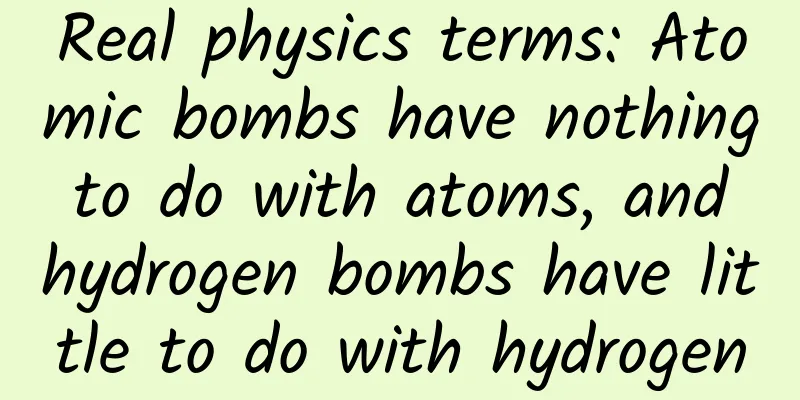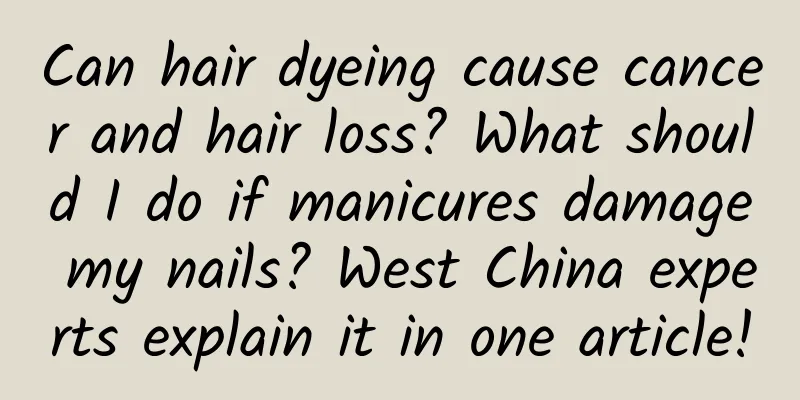Real physics terms: Atomic bombs have nothing to do with atoms, and hydrogen bombs have little to do with hydrogen

|
In scientific research, scientists create proper nouns to name new natural phenomena or new scientific concepts every time they discover them. If the names are well-named, complex phenomena and difficult concepts will be remembered or fascinating because of their intuitive and easy-to-understand names, which will arouse people's curiosity and desire to explore. If the names are not well-named, people may misunderstand or be discouraged. This series of articles will briefly examine some important nouns in physics, carefully study their meanings, and explore the profound physical meanings behind them. --author This column has published articles: 1. Getting Real About Physics Terms: Some Concepts of Force and Field Written by Chen Shaohao (Massachusetts Institute of Technology, USA) The popularity of the movie "Oppenheimer" has once again attracted public attention to the atomic bomb. As the leader of the Manhattan Project, Oppenheimer played an important role in the birth of the first atomic bomb in human history and was known as the "Father of the Atomic Bomb". Ever since Einstein wrote the mass-energy equation in 1905, physicists have known that there is a huge amount of energy hidden in tiny atomic nuclei. From the birth of scientific concepts to practical applications, countless engineering and technical difficulties need to be overcome. If it were not for the competition with Nazi Germany, the United States would not have launched the Manhattan Project to build an atomic bomb with the whole country's strength. Since its birth, the powerful nuclear weapons have completely changed the course of human history and brought great impact and influence to human society. In the mass media, many statements about nuclear weapons are vague, and some commonly used terms cannot fully and accurately express the true physical meaning behind them. Several nuclear powers in the world today regard nuclear weapons technology as the highest state secret, and the technical details of manufacturing nuclear weapons are not convenient to be made public. This is one of the reasons why some nuclear weapons terms are vague. Although the technical details of nuclear weapons are state secrets, their basic physical principles are completely public. In academia, there is no secret about the physical principles related to nuclear weapons. This article will start from the physical principles, analyze some terms related to nuclear weapons, and examine the physical content behind them. The atomic bomb has nothing to do with atoms When it comes to nuclear weapons, the most familiar thing to the public is the atomic bomb. Almost everyone in contemporary society has at least heard of the atomic bomb. However, from a scientific point of view, the term atomic bomb itself is not rigorous. The atomic bomb actually has nothing to do with atoms, but is closely related to the nucleus. The center of an atom is the nucleus, and electrons are distributed around the nucleus. The object of study of atomic physics is the electrons in the atom, and the role of the nucleus is only to provide an external electric field for the electrons. The study of the internal structure of the nucleus is called nuclear physics. The energy of an atomic bomb explosion comes entirely from nuclear fission inside the nucleus, so the more accurate name of an atomic bomb should be a fission bomb, a type of nuclear bomb. Since the atomic bomb is completely based on nuclear fission, it actually has a scientific name, called pure fission weapons. At the end of World War II, the two atomic bombs dropped by the United States on Hiroshima and Nagasaki in Japan were both pure fission weapons. The nuclear charge used in the atomic bomb is uranium-235 (U-235) or plutonium-239 (Pu-239). Uranium and plutonium are both names of elements, translated from the English words Uranium and Plutonium respectively. The Chinese names of metal elements generally have a gold radical. There are more than 90 metal elements in the periodic table, and it is not easy to name them with Chinese characters with a gold radical, and they must also have some homophony with English. Speaking of which, this is also related to Zhu Yuanzhang, the first emperor of the Ming Dynasty. Zhu Yuanzhang left a will that the third character in the name of his descendants must use a character with the "five elements" as a radical, that is, one of the "fire, earth, gold, water, and wood". In this way, the royal family of the Ming Dynasty, which lasted for more than 200 years, created many Chinese characters with a gold radical, many of which had no meaning in themselves. Unexpectedly, they were used in modern times when naming metal elements. As for uranium-235 and plutonium-239, the suffix numbers "235" and "239" are the mass numbers of the elements. The nucleus of an atom is composed of neutrons and protons, and the sum of the number of protons and neutrons is the mass number. The same element generally has many different isotopes. Isotopes have the same number of protons but different numbers of neutrons, and therefore have different mass numbers. For example, the element uranium has 92 protons, and the mass numbers of the two common isotopes are 235 and 238, respectively, so they are called uranium-235 and uranium-238. Uranium-235 and plutonium-239 are both fissionable materials that undergo fission when hit by neutrons. Fission refers to the splitting of a heavier nucleus into two lighter nuclei, releasing energy due to mass loss. Einstein's mass-energy equation E=mc^2 means that the energy of a microscopic particle is equal to its rest mass multiplied by the square of the speed of light. The speed of light is very large, so a small mass loss can produce a lot of energy. This is the source of energy for the atomic bomb. The fission of heavy nuclei also produces neutrons. The newly produced neutrons hit nearby uranium nuclei and cause them to fission as well, increasing the number of fissioning nuclei at an exponential rate. This is called a nuclear chain reaction. In just one microsecond, the number of fissioning nuclei can increase by a hundred times. The chain reaction can release the energy needed for an explosion in a short period of time. Only a few kilograms of fissioning material are needed to release enough energy to destroy a city. Figure 1: Chain reaction in an atomic bomb. A uranium-235 nucleus undergoes fission when struck by a neutron, producing two smaller nuclei and neutrons. The newly produced neutrons strike other uranium-235 nuclei, causing more fission. | Source: www.nuclear-power.com The key to detonating an atomic bomb is to squeeze the fissile material together so that it reaches the critical mass required to produce a chain reaction. There are two ways to detonate an atomic bomb. The first is the gun type. This method is like a bullet shooting at a target, using the thrust of the explosion of conventional explosives to shoot a part of the fissile material at high speed to another part of the fissile material, so that the fissile material is tightly combined together to reach the critical mass. The second is the implosion type. In this scheme, conventional explosives are on the outer layer and fissile material is on the inner layer. When conventional explosives explode, inward pressure is generated, squeezing the fissile material, so that the fissile material reaches the critical mass. The heat released by nuclear fission will cause the fissionable material to expand, causing the distance between uranium atoms to increase. Since the nuclear reaction cross section decreases rapidly with the increase of distance, the probability of newly generated neutrons hitting uranium atoms is greatly reduced, which in turn causes the chain reaction to stop. One of the keys to the design of an atomic bomb is to prevent the fissionable material from being blown apart for as long as possible so that it can be fully utilized. The nuclear cross section mentioned above is a physical quantity used to measure the probability of a reaction occurring, and has the dimension of area. The hydrogen bomb has little to do with hydrogen The hydrogen bomb is a nuclear weapon more powerful than the atomic bomb. Due to the huge destructive power of the hydrogen bomb, Oppenheimer, the father of the atomic bomb, resisted the US government's production of the hydrogen bomb for humanitarian reasons, but his security clearance was revoked, which meant the end of his political career. The movie "Oppenheimer" spent a lot of time describing the detailed process of the security clearance hearing. The opposition of famous scientists such as Oppenheimer and Einstein did not stop the development of the hydrogen bomb. Several years after the atomic bomb was made, the hydrogen bomb was successfully developed in 1951. The design of the hydrogen bomb cleverly utilizes the energy generated by nuclear fusion. In contrast to the process of nuclear fission, the nuclear fusion process is the fusion of two lighter atomic nuclei to produce a heavier atomic nucleus. The nuclear fusion process used in the hydrogen bomb is as follows: the deuterium nucleus and the tritium nucleus fuse to produce a helium nucleus and a neutron. Figure 2: Deuterium and tritium nuclei fuse to produce a helium nucleus and a neutron, and release energy | Source: wiki Deuterium and tritium are both isotopes of hydrogen. Like hydrogen, the nuclei of deuterium and tritium have one proton and one electron outside the nucleus. Since the chemical properties of an element are completely determined by the electrons outside the nucleus, the chemical properties of the three isotopes of hydrogen, deuterium, and tritium are exactly the same, and their single substances are all gases. The difference is the number of neutrons and the mass number. The mass numbers of the nuclei of hydrogen, deuterium, and tritium are 1, 2, and 3 respectively. Deuterium is called Deuterium in English, which means "second" in Greek. Tritium is called Tritium in English, which means "third" in Greek. Deuterium (pronounced Dao) and tritium (pronounced Chuan) are homophones with English. The "qi" character next to them reflects the chemical property that their single substances are gases. The two and three strokes below represent their mass numbers respectively. These two characters can be said to be a model of combining transliteration and translation. There is a mass loss in the nuclear fusion process. According to the mass-energy equation, the lost mass is converted into energy. A huge amount of nuclear fusion is taking place inside the sun every moment, and the fusion energy is radiated outward in the form of electromagnetic waves. A part of the electromagnetic waves (including visible light) propagates to the earth and becomes the source of almost all the energy on earth. Compared with nuclear fission, fusion material produces more energy per unit mass. It is worth noting that this is not the reason why hydrogen bombs are more powerful than atomic bombs. Nuclear weapons that fully utilize fusion energy are called pure fusion weapons. They only exist in theory and have not been manufactured in reality. The current hydrogen bombs do use nuclear fusion, but the main function of nuclear fusion is to produce new neutrons, which in turn cause more fission materials to undergo nuclear fission and produce greater fission energy. The main energy of hydrogen bombs still comes from nuclear fission, and the energy produced by nuclear fusion of hydrogen isotopes can be basically ignored. From this perspective, hydrogen bombs have little to do with hydrogen isotopes, so the name hydrogen bomb is not rigorous. Since nuclear fusion must require very high temperatures, the more professional term for hydrogen bombs is "thermonuclear bombs." There are two main designs for hydrogen bombs. The first is fusion-enhanced fission weapons. This is an improvement on the implosion-type atomic bomb. When an atomic bomb explodes, the nuclear fission material will be blown apart, causing the chain reaction to stop, and a lot of fission material is not used. Deuterium and tritium are heavily injected into the center of the fission material uranium, and the high temperature generated by the explosion can cause the deuterium and tritium to undergo a fusion reaction. The neutrons produced by the fusion hit the fission material on the periphery, triggering a new chain reaction of nuclear fission. In this way, the fission material is more fully utilized, and the energy released in the end is more than twice the original. Because this design uses isotopes of both fission material uranium and fusion material hydrogen, it is also called a "Uranium Hydride Bomb." The second plan was proposed by Teller and Ulam, so it is also called the Teller-Ulam plan. Teller is considered the father of the hydrogen bomb. In the movie "Oppenheimer", Teller appears as a villain and testifies against Oppenheimer at the hearing. This type of hydrogen bomb is also called a two-stage thermonuclear weapon. It consists of two fusion-enhanced fission bombs, one called a primary bomb and the other called a secondary bomb. In the first stage, a conventional explosion detonates the primary bomb. In the second stage, the high-energy X-rays produced by the explosion of the primary bomb detonate the secondary bomb. This process is called radiation implosion, which is more efficient than the first stage and releases much more energy than the primary bomb. This scheme combines the two technologies of fusion-enhanced fission and fission-enhanced fusion, so it can release energy more fully. About the Author Shaohao Chen holds a bachelor's degree in physics and a doctorate in atomic and molecular physics from Tsinghua University. He was a postdoctoral researcher at the University of Colorado Boulder, and has worked at Louisiana State University and Boston University. He is currently working at the Massachusetts Institute of Technology, engaged in high-performance computing. This article is supported by the Science Popularization China Starry Sky Project Produced by: China Association for Science and Technology Department of Science Popularization Producer: China Science and Technology Press Co., Ltd., Beijing Zhongke Xinghe Culture Media Co., Ltd. Special Tips 1. Go to the "Featured Column" at the bottom of the menu of the "Fanpu" WeChat public account to read a series of popular science articles on different topics. 2. Fanpu provides a function to search articles by month. Follow the official account and reply with the four-digit year + month, such as "1903", to get the article index for March 2019, and so on. Copyright statement: Personal forwarding is welcome. Any form of media or organization is not allowed to reprint or excerpt without authorization. For reprint authorization, please contact the backstage of the "Fanpu" WeChat public account. |
<<: If you discover dozens of tons of gold resources, will you see gold all over the mountains?
>>: Complete record of the strong typhoon "Sura", how did "Guanhai No. 1" do it
Recommend
If you don’t understand, just ask: Where does the electricity for the subway come from?
In our city, subway lines that run day and night ...
iPod is on the decline. Can smart speakers take over?
iPod is the most revolutionary music player in th...
Pilots are not allowed to have scars, but why can injured pilots continue to fly?
As we all know, the medical examination for pilot...
How to operate the lottery event in the live broadcast room!
Because public domain traffic is becoming increas...
11 super practical data form design tips, come and collect them!
Hello everyone, this is TCC Translation Intellige...
What should I do if my Tik Tok works are not recommended?
After the emergence of Kuaishou short video, shor...
How to use the "expert" economy, which is more lethal than "Internet celebrities", to market products
Jiuzhilan Interview: A one-stop strategy for buil...
Use Node.js to segment text content and extract keywords
Articles translated by Zhongcheng have tags. User...
Seven techniques to help you design high-quality UI to meet user experience needs
【51CTO.com Quick Translation】It is well known tha...
Today is the Lesser Heat. Suddenly, the warm wind arrives.
No need to drink from Heshuo, just brew tea and f...
A detailed look at the current situation of domestic charging piles shows that the number is increasing slowly and there are many problems
The electric vehicle market is developing rapidly...
Tesla's future is in China? 40% of Tesla's global sales in 2022 may come from China
Tesla built its first overseas factory in Shangha...
Private rockets have been successfully launched one after another, and the future of China's commercial aerospace industry is promising!
Recently, the CPC Central Committee and the State...
How do information flow ads dominate HeroAPPs such as Toutiao and Weibo?
Information flow advertising first appeared on th...
Don't take cold medicine randomly during flu season! Doctors: These medicines cannot be taken with cold medicine!
Recently, information released by the Chinese Cen...









